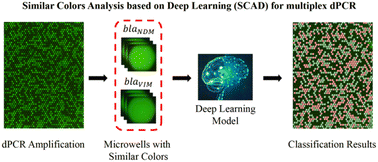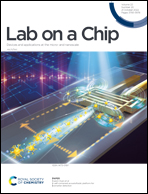Similar color analysis based on deep learning (SCAD) for multiplex digital PCR via a single fluorescent channel†
Abstract
Digital PCR (dPCR) has recently attracted great interest due to its high sensitivity and accuracy. However, the existing dPCR depends on multicolor fluorescent dyes and multiple fluorescent channels to achieve multiplex detection, resulting in increased detection cost and limited detection throughput. Here, we developed a deep learning-based similar color analysis method, namely SCAD, to achieve multiplex dPCR in a single fluorescent channel. As a demonstration, we designed a microwell chip-based diplex dPCR system for detecting two genes (blaNDM and blaVIM) with two kinds of green fluorescent probes, whose emission colors are difficult to discriminate by traditional fluorescence intensity-based methods. To verify the possibility of deep learning algorithms to distinguish the similar colors, we first applied t-distributed stochastic neighbor embedding (tSNE) to make a clustering map for the microwells with similar fluorescence. Then, we trained a Vision Transformer (ViT) model on 10 000 microwells with two similar colors and tested it with 262 202 microwells. Lastly, the trained model was proven to have highly accurate classification ability (>98% for both the training set and the test set) and precise quantification ability on both blaNDM and blaVIM (ratio difference <0.10). We envision that the developed SCAD method would significantly expand the detection throughput of dPCR without the need for other auxiliary equipment.

- This article is part of the themed collection: AI in Microfluidics


 Please wait while we load your content...
Please wait while we load your content...